In a world increasingly aware of the importance of sustainability and health, palm leaf plates emerge as a superior choice for both individuals and the environment. This article delves into the myriad benefits of choosing palm leaf plates over traditional disposable options, exploring their environmental impact, health advantages, economic benefits, and aesthetic appeal.
Table of Contents
Introduction to Palm Leaf Plates
What are Palm Leaf Plates?
Palm leaf plates are eco-friendly disposable plates made from the fallen leaves of the Areca palm tree. These plates are crafted through a natural process that involves collecting, cleaning, and heat-pressing the leaves into various shapes and sizes, requiring no chemicals or additives.
The History of Palm Leaf Plates
The use of palm leaves for dining purposes dates back centuries, primarily in countries like India, where they were a staple at traditional meals. Their modern resurgence as disposable plates is driven by a growing demand for sustainable and eco-friendly products.
Environmental Benefits
Biodegradability and Compostability
One of the most significant environmental benefits of palm leaf plates is their 100% biodegradability and compostability. Unlike conventional plastic or Styrofoam tableware that can take hundreds of years to decompose, contributing to landfill overburden and marine pollution, palm leaf plates break down naturally within a few months when composted. This rapid decomposition returns valuable nutrients to the soil, enhancing soil health without releasing harmful chemicals or microplastics into the environment.
Reduction in Carbon Footprint
The manufacturing process of palm leaf plates is inherently low-impact, utilizing minimal energy and producing fewer greenhouse gases compared to the production of plastic or even paper plates. Since the raw material is sourced from naturally shed leaves, there is no need for the felling of trees or significant agricultural inputs, further reducing the carbon footprint associated with their production. Moreover, the end-of-life disposal of palm leaf plates through composting emits negligible carbon dioxide, making their overall lifecycle markedly more eco-friendly.
Sustainable Sourcing
Sustainability is at the core of palm leaf plate production. The Areca palm trees, from which the leaves are harvested, are not cut down or harmed during the collection process. These trees continue to grow and shed leaves naturally, providing a renewable and sustainable source of material for plate manufacturing. This practice not only ensures the conservation of forests but also supports the ecological balance by not disrupting habitat or biodiversity.
Promotion of Waste Reduction
By choosing palm leaf plates, consumers and businesses contribute to a reduction in waste generation. The disposable nature of these plates, combined with their eco-friendly composition, offers a guilt-free convenience that plastic and Styrofoam products cannot match. In events, catering, and fast-food industries, where disposable tableware is often a necessity, palm leaf plates provide a responsible option that significantly lowers the environmental footprint of these activities.
Encouragement of Eco-conscious Consumption
The growing popularity of palm leaf plates reflects and encourages a broader shift towards eco-conscious consumption patterns. By opting for products that are not only sustainable but also promote environmental health, individuals and organizations can play a part in driving demand for green alternatives. This demand further stimulates innovation in sustainable product development, fostering a more eco-friendly economy.

Health and Safety Advantages
Chemical-Free Manufacturing Process
Palm leaf plates are produced through a remarkably simple and natural process. The leaves of the Areca palm tree are collected after they fall to the ground, cleaned with water, and then heat-pressed into various shapes and sizes. This method does not involve the use of chemicals, plastics, glues, or synthetic additives, which are common in the production of plastic and even some paper tableware. As a result, there is no risk of these harmful substances leaching into food, especially when it comes into contact with hot or acidic foods, making palm leaf plates a safer option for consumers.
Non-Toxic and Allergen-Free
Given their natural origin and chemical-free manufacturing, palm leaf plates are non-toxic and free from allergens. This makes them suitable for everyone, including individuals with chemical sensitivities or allergies to plastics and metals. Unlike plastic plates, which can contain BPA (Bisphenol A) and other endocrine-disrupting chemicals, palm leaf plates offer peace of mind, knowing that the material in contact with your food is pure and safe.
Compatibility with Hot and Cold Foods
Palm leaf plates are remarkably durable and capable of handling both hot and cold foods without degrading or releasing any hazardous substances. This is a significant advantage over some disposable options that may warp, melt, or leach chemicals when exposed to high temperatures. Consumers can safely use palm leaf plates for a wide range of culinary applications, from serving hot meals to storing cold dishes, without concern for health risks.
Eco-friendly and Health-conscious Choice
Choosing palm leaf plates also reflects a broader commitment to health and sustainability. By opting for products that are good for the planet, consumers indirectly support their own health. A cleaner environment results in better air and water quality, which benefits everyone’s health. Furthermore, the move away from plastic and other polluting materials helps reduce overall exposure to harmful chemicals in the environment, contributing to long-term well-being.
Compliance with Safety Standards
Palm leaf plates are subject to rigorous safety standards and testing to ensure they are fit for use. They are typically certified compostable and may also meet specific food safety standards, reassuring consumers about their quality and safety. These certifications confirm that palm leaf plates can be used confidently at home, in restaurants, and at events, providing a safe dining experience for all.
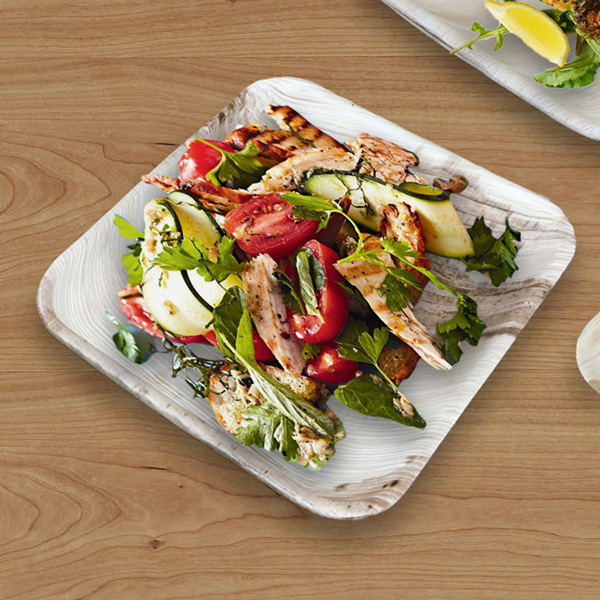
Economic and Social Impacts
Support for Local Economies
The production of palm leaf plates typically occurs in rural areas where the Areca palm trees are naturally abundant. This industry provides a vital source of income for local communities, particularly in countries like India, where such practices have deep cultural roots. By purchasing palm leaf plates, consumers directly contribute to the economic sustainability of these areas. The demand for palm leaf products supports artisans and workers who rely on traditional skills and local resources, thereby injecting financial resources into communities that might otherwise struggle economically.
Employment Opportunities in Rural Areas
Manufacturing palm leaf plates creates employment opportunities, especially in regions where job options may be scarce. The process of collecting, cleaning, and pressing the leaves into plates is labor-intensive, requiring a significant workforce. This industry can significantly reduce rural unemployment, offering stable employment to people in these areas. Moreover, as the global demand for eco-friendly products increases, there is potential for job growth in the sector, providing long-term employment prospects for individuals in producing regions.
Promotion of Sustainable Practices
The palm leaf plate industry promotes sustainable agricultural and manufacturing practices. Since the raw material is sourced from fallen leaves, there is no need for deforestation or the intensive use of water, pesticides, and fertilizers typically associated with other crops. This sustainable sourcing not only conserves natural resources but also educates and encourages communities to maintain biodiversity and practice environmental stewardship. Furthermore, the compostability of palm leaf plates reduces waste and pollution, contributing to cleaner communities and ecosystems.
Social Responsibility and Ethical Consumption
Choosing palm leaf plates reflects a commitment to social responsibility and ethical consumption. Consumers become part of a larger movement that values the well-being of the environment, the health of individuals, and the prosperity of communities. This shift towards ethical consumption encourages businesses to adopt fair trade practices, ensuring that workers are paid fairly and work in safe conditions. As awareness grows, more companies are motivated to invest in sustainable and socially responsible products, leading to broader positive impacts on global trade and labor practices.
Cultural Preservation and Global Awareness
The global interest in palm leaf plates also helps preserve cultural traditions associated with the use of natural materials for dining. In many cultures, eating on palm leaves is a centuries-old tradition that embodies respect for nature and sustainable living. By commercializing these products on a global scale, there is an opportunity to share and preserve these cultural practices, fostering a greater appreciation for traditional knowledge and environmental harmony.
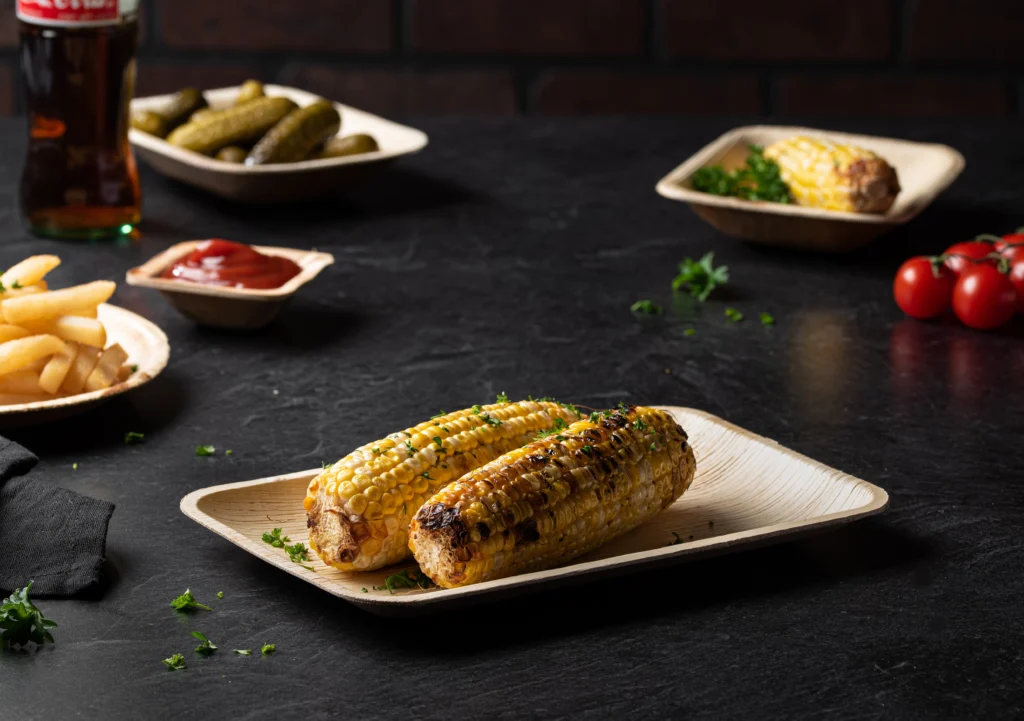
Practicality and Aesthetics
Versatility for Various Occasions
One of the most compelling attributes of palm leaf plates is their versatility. They are suitable for a wide array of occasions, from casual backyard barbecues to elegant wedding receptions. Their natural, rustic look can complement any decor style, adding a touch of earthiness and warmth to the dining experience. Moreover, palm leaf plates are available in various shapes and sizes, accommodating different types of food and serving styles. Whether it’s a formal dinner, a picnic, or a corporate event, these plates can adapt to the needs of the occasion without compromising on style or functionality.
Durability and Leak Resistance
Despite being biodegradable and compostable, palm leaf plates are remarkably durable. They are sturdy enough to hold heavy or moist foods without bending, breaking, or leaking. This strength comes from the natural fibrous material of the palm leaf, which, when pressed into shape, retains a high degree of rigidity and resilience. This makes palm leaf plates a practical option for serving a variety of dishes, including those with sauces or dressings, without the worry of leaks or spills.
Unique Aesthetic Appeal
Each palm leaf plate has a unique texture and pattern, reflecting the natural beauty of the leaf it was made from. This individuality adds an authentic and sophisticated touch to meal presentations, making each plate a conversation starter. The warm, earthy tones of the palm leaves enhance the visual appeal of the food served on them, making dishes look more inviting and appetizing. For events where presentation matters, palm leaf plates offer an aesthetic advantage that plastic or paper plates simply cannot match.
Eco-friendly Elegance
In addition to their practical benefits, the use of palm leaf plates sends a positive message about environmental responsibility. Choosing these plates over plastic or other non-biodegradable options demonstrates a commitment to sustainability, which is increasingly appreciated by guests and customers. This eco-friendly elegance adds value to events and establishments that prioritize green practices, enhancing their reputation and appeal to environmentally conscious consumers.
Easy Disposal and Cleanup
After use, palm leaf plates can be composted, offering a hassle-free cleanup process that aligns with sustainable waste management practices. This easy disposal method is particularly advantageous for large events, where the volume of waste can be overwhelming. Instead of contributing to landfill waste, used palm leaf plates can be turned into compost, enriching the soil and supporting the cycle of growth. This practical benefit further elevates palm leaf plates above their plastic counterparts, which often end up polluting the environment.
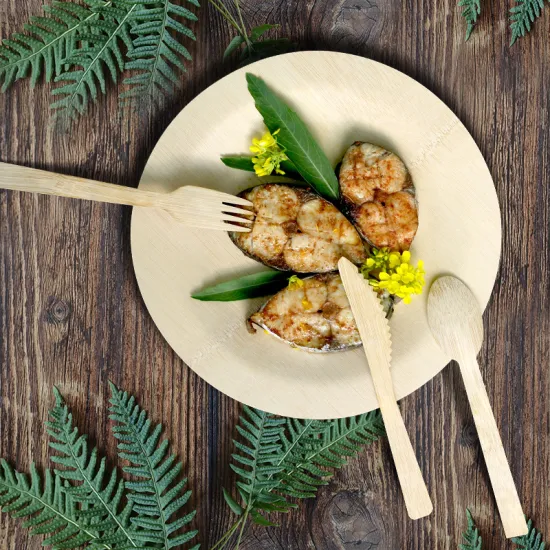
Comparisons With Other Disposable Plates
Palm Leaf vs. Plastic Plates
Environmental Impact: The most striking difference between palm leaf and plastic plates is their environmental impact. Palm leaf plates are biodegradable and compostable, breaking down naturally within a few months without harming the environment. In contrast, plastic plates are made from petroleum-based plastics that can take hundreds to thousands of years to degrade, contributing significantly to landfill waste and pollution.
Health and Safety: Palm leaf plates are produced using a chemical-free process from naturally fallen leaves, making them a safer choice for serving food. They do not leach harmful chemicals into food, a concern associated with plastic plates, especially when used with hot foods. Plastics can contain BPA and other chemicals that may pose health risks over long-term exposure.
Aesthetic Appeal: Palm leaf plates have a unique, natural look that adds warmth and sophistication to any meal setting. Each plate has a distinct pattern and texture, reflecting its natural origin. Plastic plates, while available in various colors and designs, lack the authentic, rustic charm of palm leaf plates and often feel less premium.
Palm Leaf vs. Paper Plates
Sustainability: While paper plates are often touted as a more eco-friendly option compared to plastic, they still have significant environmental drawbacks. The production of paper plates typically involves deforestation and high water usage. Although they are biodegradable, some are coated with plastic or wax to prevent leaks, which complicates the composting process. Palm leaf plates, on the other hand, utilize a renewable resource without the need for deforestation or intensive water use, and they are entirely compostable.
Durability and Functionality: Palm leaf plates are generally more durable and sturdy than paper plates. They can handle heavy, hot, or moist foods without bending, soaking through, or falling apart. Paper plates, especially the thinner varieties, can easily become soggy with wet foods or collapse under the weight of heavy items, leading to spills and messes.
Health Considerations: Similar to palm leaf plates, paper plates do not typically release harmful chemicals into food. However, the environmental and health impact of the production process, including the use of bleaches and dyes in some paper plates, can be a concern. Palm leaf plates remain a more natural, chemical-free option.

User Experiences and Testimonials
Appreciation for Environmental Impact
A significant number of testimonials focus on the eco-friendly nature of palm leaf plates. Users appreciate the sustainability aspect, knowing that their use of palm leaf plates contributes to reducing waste and environmental pollution. The fact that these plates are biodegradable and compostable adds to their appeal, with many customers noting the satisfaction they feel in aligning their purchasing choices with their environmental values. For those looking to minimize their carbon footprint, palm leaf plates have become a go-to option for disposable tableware.
Aesthetic Appeal and Unique Presentation
The natural, rustic look of palm leaf plates receives a lot of praise from users. Each plate’s unique texture and pattern are often mentioned as conversation starters at events, offering a distinctive and elegant alternative to the uniform appearance of plastic or paper plates. Customers have shared how the aesthetic appeal of palm leaf plates enhances the overall presentation of their food, making meals look more appetizing and special. This has been particularly valued in settings where presentation matters, such as at weddings, formal dinners, and catering events.
Positive Impact on Guest Perception
Many users have noted the positive reactions they’ve received from guests when using palm leaf plates. Guests are frequently impressed by the combination of durability, beauty, and sustainability, which sets these plates apart from traditional disposable options. This positive feedback has encouraged more hosts to choose palm leaf plates for their events, contributing to a growing trend towards eco-conscious entertaining.
Ease of Cleanup and Disposal
The convenience of cleanup and disposal is another benefit frequently highlighted in user testimonials. Being compostable, palm leaf plates can be disposed of in an eco-friendly manner, which is particularly appreciated by those who compost at home or have access to composting facilities. This ease of disposal, combined with the practical benefits of using disposable plates, makes palm leaf plates a popular choice for both large events and everyday use.
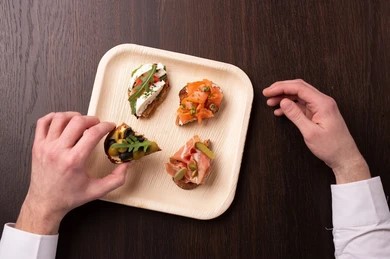
Conclusion
Palm leaf plates represent a convergence of sustainability, health, and practicality, offering a compelling alternative to traditional disposable plates. By choosing palm leaf plates, individuals can contribute to a healthier planet, support sustainable practices, and enjoy a unique dining experience.
FAQs
- Are palm leaf plates suitable for hot and wet foods? Yes, palm leaf plates are sturdy and resistant to heat and moisture, making them suitable for all types of food, including hot, wet, and oily dishes.
- How long does it take for palm leaf plates to biodegrade? Palm leaf plates typically biodegrade within a few months when composted, significantly faster than plastic or non-compostable materials.
- Can palm leaf plates be reused? While palm leaf plates are designed for single use, they can be gently cleaned and reused for dry or light foods if they have not been heavily soiled.
- Are palm leaf plates more expensive than traditional disposable plates? Palm leaf plates may be slightly more expensive than plastic or paper plates due to their natural and sustainable manufacturing process. However, their environmental and health benefits can justify the extra cost.
- Where can I purchase palm leaf plates? Palm leaf plates are available at many online retailers, eco-friendly stores, and specialty kitchenware shops. It’s important to buy from reputable sources to ensure the quality and sustainability of the plates.
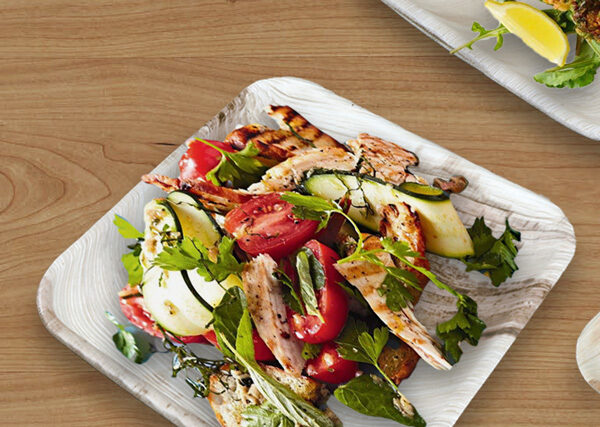
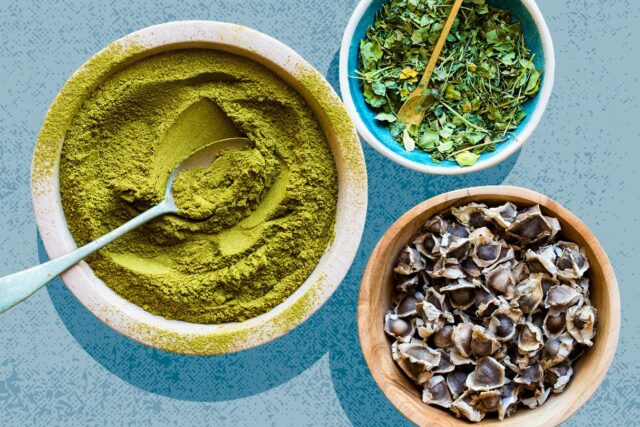

MOST COMMENTED
Animal-Based Proteins / Casein Protein / Dietary Protein / High-Protein Diets / Pea Protein / Plant-Based Proteins / Protein / Protein Deficiency / Protein Supplements / Proteins / Whey Protein / Whey Proteins
Is Protein Powder Safe for Teenagers and Children?
Animal-Based Proteins / Casein Protein / Dietary Protein / High-Protein Diets / Pea Protein / Plant-Based Proteins / Protein / Protein Deficiency / Protein Supplements / Proteins / Whey Protein / Whey Proteins
Unlock the Power of Proteins for Optimal Gut Health
Multivitamin
Total Health: Multivitamin for Active Lifestyles
Multivitamin
WellnessFusion: Complete Multivitamin Support
Dietary Supplement
Revitalize Your Health: The Magic of Red Yeast Rice Capsules
Foot care / Foot Health
Revitalize Your Foot Care Routine: Essential Tips for Optimal Foot Health
Foot Problem / Diabetics / Foot Health
Diabetics: Mastering Footwear Selection for Enhanced Foot Health and Ultimate Comfort
Exercises and Footwear Tips for Hammertoe Relief / Foot care / Foot Health / Foot Pain / Foot Problem / Hammertoes
Unlock Effective Exercises and Footwear Tips for Hammertoe Relief
Hammertoes / Foot Health / Foot Pain / Foot Problem
Unlock Relief: Essential Guide to Hammertoes Causes, Symptoms, and Treatments
Foot Problem / Foot Health
Revolutionize Your Recovery: Natural Remedies for Plantar Fasciitis – Fresh Home Keepers